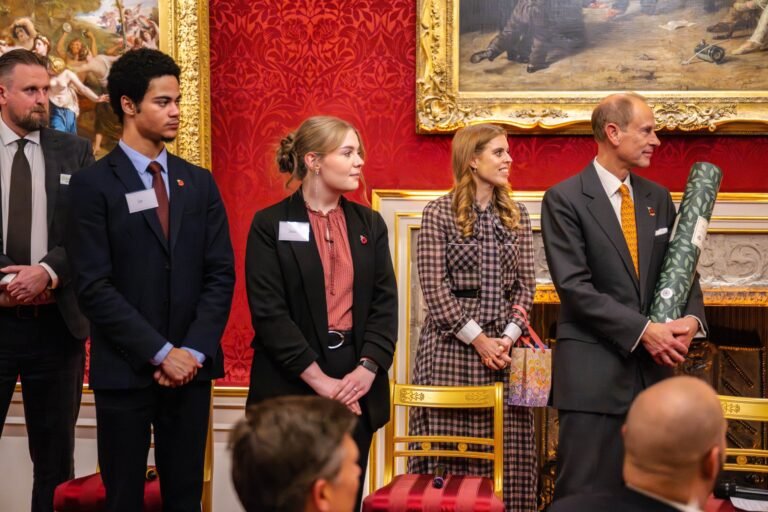Today is Accession Day – 6th February does not only mark the beginning of another year on the throne for the longest reigning Monarch; 2017 means it is also The Queen’s Sapphire Jubilee, a milestone no other Sovereign in British history has reached.

It will not be marked with fanfare or occasion as the Diamond Jubilee of 2012 was. Instead, Her Majesty will be preparing to return from the Sandringham Estate to resume her public duties in London once more. She has, of course, been keeping up with her red boxes and other ‘behind-the-scenes’ monarchical duties over the course of her break.
A 41-gun salute will take place at noon by the King’s Troop Royal Horse Artillery in Green Park, to mark Accession Day in the traditional way, and the Band of the Royal Artillery will play a selection of celebratory music there, too.
But for The Queen, this day is always tinged with sadness: George VI died at Sandringham in his sleep in 1952. While he had been treated for lung cancer, having had part of his lung removed in 1951, and was not in the best of health, few expected the King’s death as Princess Elizabeth and The Duke of Edinburgh toured the Commonwealth.

Who else has reached a Sapphire Jubilee?
Just four other rulers have made it this far in history (as far as we know!).
- Louis XIV of France celebrated this milestone in 1708
- Emperor Franz Joseph I of Austria-Hungary – 1913
- Prince Johannes II of Lichtenstein – 1923
- Bhumibol Adulyadej (Rama IX) of Thailand – 2011
Who are the longest reigning Monarchs in British history?
This includes the rulers of England from 1066, and those of Scotland and Wales before they were annexed/united with England.
1. Elizabeth II of the United Kingdom 1952-present, 65 years to date. (GSTQ!) The longest-reigning Monarch in British history. Also considered to be the most popular.
2. Victoria of the United Kingdom 1837-1901, 63 years. Known for her continual mourning after the death of Prince Albert, Queen Victoria’s reign marked a period of innovation and expansion for the United Kingdom.
3. George III of the United Kingdom 1760-1820, 59 years. What may have been bipolar disorder – and not porphyria – King George was noted for his serious interest in governance.

4. James VI of Scotland (and I of England) 1567-1625, 57 years. James united the Crowns of England and Scotland in his person. Despite his promise to return to his homeland each year as he lived in London, he only made it back twice in his 22 year stint as the English Monarch.
5. Henry III of England 1216-1272, 56 years. Henry sought to be a dignified ruler, and to use his authority leniently, hoping to maintain peace in England with the hostile barons. The King is responsible for rebuilding Westminster Abbey, mostly as it is seen today.
6. Edward III of England 1327-1377, 50 years. While the English suffered the disastrous Black Death during Edward’s reign, the King was noted for his military might, gaining extensive French lands. He had taken the throne from his mother, Isabella of France, in a coup, who had snatched it from her husband.
7. William I of Scotland 1165-1214, 48 years. Quite a contrast to his deeply religious, frail brother Malcolm, William was powerfully built and headstrong. Though an effective ruler, his reign was marred by ill-fated attempts to regain Northumbria from the Normans.
8. Llywelyn II of Gwynedd 1194/5-1240, 44-46 years. Married to King John’s daughter, Joan, Llywelyn dominated Wales through alliances and military force. He also forced John to sign Magna Carta with the barons.
9. Elizabeth I of England and Ireland 1558-1603, 44 years. ‘Gloriana’ was the unexpectedly successful daughter of Henry VIII. She sought a ‘via media’ (middle way) in her religious settlements to placate the Catholics after Mary I’s reign and the Protestants who sought security after it.
10. David II of Scotland 1329-1371, 41 years. David was the last male of the House of Bruce, with his father the famous Robert the Bruce. He spent long periods in exile or captivity, but managed to resist Edward III’s attempts to annex Scotland, leaving a strong throne behind.
11. Henry VI of England [and France] 1422-1461 (first reign), Oct 1470 – April 1471 (second reign), total 38 years. Henry VI was embroiled in the Wars of the Roses, which saw him lose and then regain his throne. It is thought he was murdered on the order of new Yorkist King, Edward IV.

12. Aethelred II 978-1013 (first reign), 1014-1016, total 37 years 362 days. The ‘Unready’ or ill-advised King fought often with the Danes, and had to flee to Normandy as his throne was taken. Coinage quality increased under his reign, a sign of economic prosperity.
13. Henry VIII 1509-1547, 37 years 281 days. Obese and paranoid by the end of his reign, the Tudor King earned himself the title ‘Fidei Defensor’ (Defender of the Faith) for his pamphlets defending the Catholic Church against Lutheran criticisms. British Monarchs still use this style today.
14. Charles II 1649-1689, 36 years (he was proclaimed King of Scotland upon the death of his father, Charles I). The Merrie Monarch was known for his love of all things decadent, partially in response to the ‘beige’ days of Oliver Cromwell’s republic.
15. Henry I 1100-1135, 35 years. Henry, a younger son of William the Conqueror, came to the throne after his elder brother was killed in a hunting accident. He is considered a harsh but effective ruler, managing to manipulate the barons in England and Normandy, through the justice system, local government and taxation.









